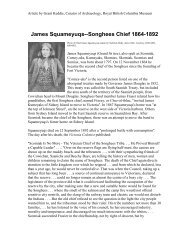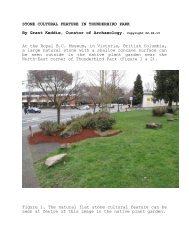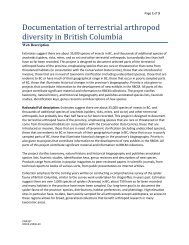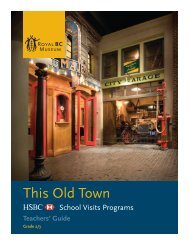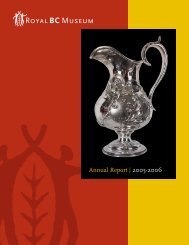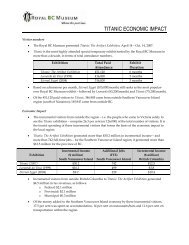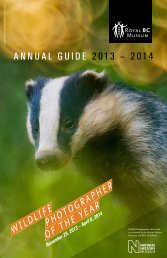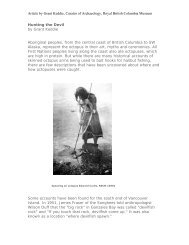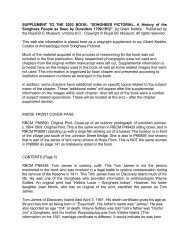BACKGROUNDER - Royal BC Museum
BACKGROUNDER - Royal BC Museum
BACKGROUNDER - Royal BC Museum
You also want an ePaper? Increase the reach of your titles
YUMPU automatically turns print PDFs into web optimized ePapers that Google loves.
<strong>BACKGROUNDER</strong><br />
2003MCAWS0026-000179<br />
Feb. 17, 2003<br />
Ministry of Community, Aboriginal and Women's Services<br />
ROYAL BRITISH COLUMBIA MUSEUM<br />
The <strong>Royal</strong> British Columbia <strong>Museum</strong> contains detailed information on all of the province's natural and<br />
human history. It houses a collection of over 10 million objects and specimens valued at $600 million.<br />
Founded in 1886, the museum developed in the wings of the provincial legislative buildings until its<br />
current building was erected as a Canadian centennial project in 1967. The museum building<br />
comprises a research and collections tower named for John Fannin, the museum’s first curator.<br />
In its new location, the museum created state-of-the art exhibits on the province’s natural history and<br />
human history and devoted another gallery to British Columbia’s First Peoples. Open Oceans, the last<br />
large permanent exhibit, was added in 1987.<br />
Also on the site is a First Nations carving studio and Big House, as well as Thunderbird Park, famous<br />
for its totems. These areas are programmed and interpreted through a partnership with Victoria’s<br />
Native Friendship Centre. St. Ann’s schoolhouse on Elliott Square dates to 1843 and was used by the<br />
Sisters of St. Ann’s.<br />
In 1996, the province granted the museum special operating agency status, thereby allowing it to<br />
conduct business in a more entrepreneurial fashion. Since then, the museum has added a National<br />
Geographic Imax Theatre through a public-private partnership, licensed the provision of food services<br />
in an enhanced museum café, introduced a gallery rentals program and expanded its museum shop.<br />
Marketing synergies with community and tourism partners have been developed and fostered. These<br />
activities aided the <strong>Royal</strong> British Columbia <strong>Museum</strong> in augmenting revenues, especially through<br />
special exhibits like Dragon Bones: When Dinosaurs Ruled China (signed for 2003); Circus Magicus,<br />
(1999/2000); Leonardo da Vinci: Scientist, Inventor, Artist (1998/99); and Empires Beyond the Great<br />
Wall (1995/96). These relationships allowed the museum to sustain its position as a world-class<br />
cultural institution.<br />
In the fall of 2001, the government directed the museum to review its operations and examine ways to<br />
improve services. In November 2002 at an open cabinet meeting, the government approved the<br />
museum’s recommendation that the <strong>Royal</strong> British Columbia <strong>Museum</strong> become a Crown entity and the<br />
British Columbia Archives, Helmcken House and the Netherlands Carillon – previously under the<br />
purview of four separate ministries – be amalgamated with the museum to form a cultural precinct.<br />
-more-
- 2 -<br />
CULTURAL PRECINCT<br />
British Columbia Archives<br />
The B.C. Archives, started in 1898, is the central archives service for the government of British<br />
Columbia, and provides research access to records of enduring value to the province for both the<br />
provincial government and public clientele.<br />
The archival holdings, valued at $100 million, include government documents and records; private<br />
historical manuscripts and papers; maps, charts and architectural plans; photographs; paintings,<br />
drawings and prints; audio and video tapes; film; newspapers; and an extensive library of publications<br />
with a strong emphasis on the social and political history of British Columbia and the Pacific<br />
Northwest.<br />
The archives moved into its present location in 1970 and added a sound and moving image division in<br />
1975.<br />
Helmcken House<br />
The house was built by Dr. John Sebastian Helmcken and is the oldest house in British Columbia on its<br />
original site that is open to the public. Helmcken, a surgeon with the Hudson’s Bay Company, set up<br />
house in Victoria when he married the daughter of Governor Sir James Douglas in 1852. He went on to<br />
become a statesman and helped negotiate the entry of British Columbia into Canada as a province.<br />
Helmcken House, originally a three-room log structure, offers a glimpse into the way life was lived<br />
over a hundred years ago. One of the collections is the doctor's original 19th century medical kit.<br />
The Netherlands Carillon<br />
The Netherlands Carillon in Victoria was a gift of the Dutch community of British Columbia to the<br />
people of the province in honor of Canada’s Centennial.<br />
Queen Juliana of the Netherlands laid the cornerstone on May 23, 1967. The tower was completed and<br />
officially opened a year later. There are 75 steps on the staircase that turns through six complete<br />
circles, a 10-step ladder to reach the playing room, plus anotherladder to the belfry. The bells were<br />
cast at <strong>Royal</strong> Bell Foundry at Petit and Fritsen in the Netherlands. The tower stands 27 metres tall at<br />
the corner of Government and Belleville streets.<br />
The Netherlands Centennial Carillon became the largest in Canada in 1971 with the addition of 13<br />
bells, bringing the total to 62, nine more than the Peace Tower at the Parliament Buildings in Ottawa.<br />
The original carillonneur was the late Herman Bergink. His efforts to build and the carillon for the<br />
people of B.C. resulted in his being knighted by Queen Beatrix of the Netherlands.<br />
Visit the province's Web site at http://www.gov.bc.ca/ for online information and services.<br />
-30-<br />
Media<br />
contact:<br />
Sharon Henwood<br />
Corporate Communications Manager<br />
<strong>Royal</strong> British Columbia <strong>Museum</strong><br />
250 356-7226<br />
250 387-2135 (direct)<br />
Marisa Adair<br />
Communications Director<br />
Community, Aboriginal and Women's Services<br />
250 387-4089



